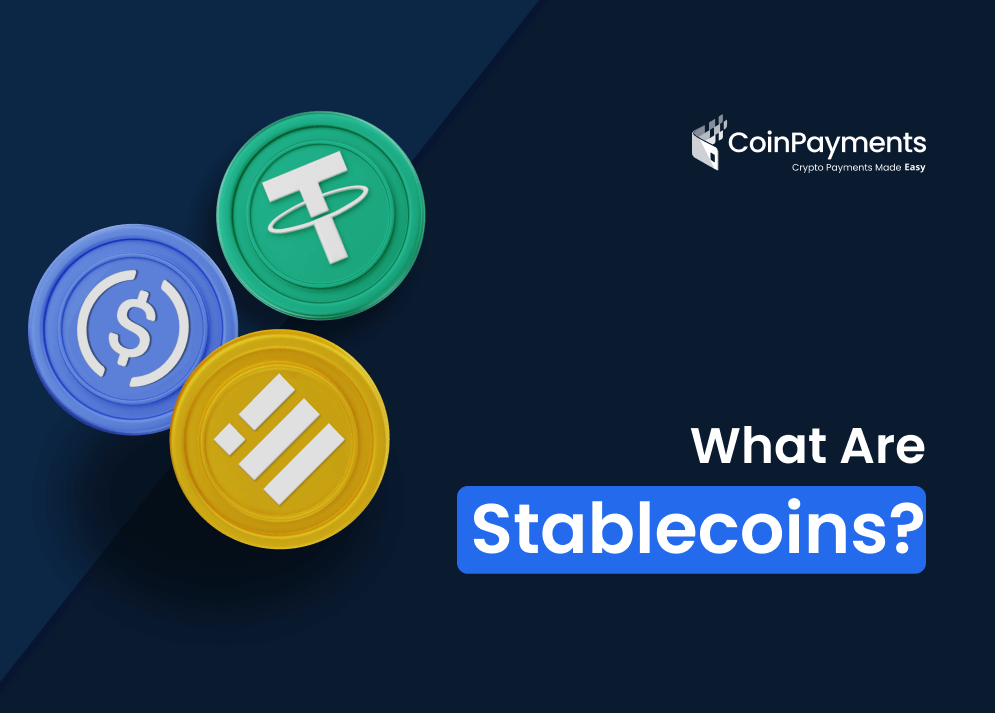
More merchants than ever before are accepting cryptocurrencies, and that’s a good thing! The crypto market is decentralized, secure, and enables store owners just like you to accept payments from around the world in moments. By accepting cryptocurrencies, you increase your potential customer base and may see greater profits down the road.
But the crypto market’s general stability is only because of unique crypto-tokens called stablecoins. These vital pieces of the crypto market play a big role in the value of popular coins like Bitcoin. Today, let’s take a deep dive into stablecoins and break down what they do to help cryptocurrency as an industry.
Stablecoins Explained
In a nutshell, stablecoins are specialized cryptocurrencies with the sole purpose of helping ensure price stability for the broader crypto market. Unlike many other popular crypto tokens, like Bitcoin, stablecoins are backed by reserve assets, such as metals, the US dollar, and others.
Basically, stablecoins exist to solve one of the primary perceived problems of the crypto market: instability. For example, even though Bitcoin is more popular than ever and has achieved relative stability compared to other crypto tokens, its value is still highly volatile compared to fiat currencies like the dollar or euro.
To accomplish market stability, stablecoins are pegged to currencies or other assets like gold or the dollar. Once done, they use collateralization or backing plus certain algorithmic mechanisms so that they are bought and sold using their “pegged” assets.
What is the Purpose of Stablecoins?
Their purpose is for market stability and reduced volatility for popular cryptocurrencies like Bitcoin, plain and simple.
Let’s get more specific and look at Bitcoin since it’s the most popular cryptocurrency for now. Although Bitcoin is now accepted at many retail and online stores, it still suffers from high volatility when it is valued.
As an example, Bitcoin’s value rose from $5000 per BTC around March 2020 all the way up to nearly $65,000 per BTC in April 2021. However, the end of June 2021 saw the value of a Bitcoin drop to $30,000 or so. As you can see from this example, Bitcoin’s volatility is very high despite its perceived popularity.
This prevents many classical investors or companies from investing in cryptocurrencies, even though they offer other benefits like decentralization and no FDIC oversight by regulators. Remember, one of the core purposes of any agreed-upon currency is to act as a monetary exchange medium.
To perform as a good monetary exchange unit, a crypto token’s value has to be relatively stable. Otherwise, it will be difficult to get people to adopt that new medium.
Stablecoins are the potential solution. By having their value constantly attached to other assets, like the US dollar, they influence the price fluctuations of the entire cryptocurrency market.
While they don’t directly influence the valuation of tokens like Bitcoin, Ether, and so on, they still prevent them from experiencing as high or low price fluctuations.
This, in turn, makes the cryptocurrency market more acceptable to the broader public and makes crypto tokens safer investments for everyday spenders/investors.
Stablecoin Types
However, there’s no such thing as just one “stablecoin”. Instead, there are many different types of stablecoins. Technically, there are four different types of stablecoins that people can invest in or pay attention to.
Fiat-Collateralized Stablecoins
As the name of these stablecoins suggests, these tokens are backed by fiat currencies, such as the dollar. A fiat currency is only backed by the word of its issuing government. For example, the dollar is backed by the promise of the US government. This alone gives it value, not something concrete like gold.
On the plus side, all fiat-backed stablecoins are backed at a ratio of 1 to 1. For example, one fiat-collateralized stablecoin is equal to one unit of its backed currency. So when someone tries to redeem their coins for cash, they get the same value in fiat currency as they have for their stablecoins.
Most fiat-collateralized stablecoins are backed with stable fiat currencies, like the euro or dollar. Tether and USD Coin are two of the most popular stablecoins backed by the US dollar, although they’ve come under controversy in recent years.
Commodity-Collateralized Stablecoins
Commodity-collateralized stablecoins are backed by interchangeable assets other than fiat currencies. By far the most common commodity is gold, as this is broadly recognized as valuable throughout the world. You can also find commodity-collateralized stablecoins backed by other precious metals, oil, and even real estate. Some coins are backed by digital assets, as well.
Those holding commodity-collateralized stablecoins often invest in this market since the assets backing the coins can appreciate or depreciate over time. This may allow them to make a profit through smart trading and investing.
Crypto-Collateralized Stablecoins
Crypto-collateralized stablecoins are, naturally, stablecoins backed by other cryptocurrencies. This unique class of stablecoins is more decentralized than others, but it has a higher volatility risk than other stablecoins.
Still, crypto-collateralized stablecoins are more stable than other crypto tokens since transactions are conducted using secure blockchain technology, often over collateralized. Thus, the tokens can absorb price fluctuations in most cases.
Non-Collateralized Stablecoins
non-collateralized stablecoins are technically not stablecoins at all, since they aren’t backed by anything (let alone something stable). However, some investors and crypto traders still use these stablecoins thanks to the sophistication of their algorithms.
These stablecoins use algorithms to control the supply of their coins (using an algorithmic model called seignorage shares).
Supporters of these coins believe in their value in the same way that people believe in the value of fiat currencies – that is, they choose to believe in their value rather than rely on an underlying asset.
Popular Stablecoins
To date, there have been dozens of high-quality stablecoins released to the market. Some of the most popular stablecoins currently include:
Tether
Tether is one of the oldest stablecoins in existence, as it launched in 2014. This popular stablecoin is one of the most valuable when measured by market capitalization. Most traders use Tether or USDT to move money between different crypto exchanges quickly. Note that Tether was recently embroiled in some legal troubles, though they have since been settled
USD Coin or USDC
USDC is a jointly managed stablecoin run by the cryptocurrency firms Coinbase and Circle. This stablecoin is pegged closely to the US dollar’s value and currently has a circulating supply of nearly $26 billion
Dai
Dai is an Ethereum blockchain stablecoin. This stablecoin was created in 2015 and is currently pegged to the US dollar. It’s also backed by Ether. Ethereum smart contracts handle most of the security and trust for these stablecoins
Facebook tried to launch its stablecoin in the past, which would have been called Diem. In theory, this unique stablecoin would have been pegged to a basket of several currencies, like the euro and US dollar. Unfortunately, Facebook has decided against making one centralized stablecoin and now seeks to develop multiple, each intended to be backed by a different currency
More stablecoins could be released in the future by new issuers. Financial services companies may seek to create new algorithmic stablecoins to stabilize the crypto financial system further.
As more use stablecoins, we may even see a kind of central bank digital currency to ensure the stability of all important crypto assets and the healthy of the overall ecosystem.
Are There Downsides to Stablecoins?
While stablecoins are important for the broader crypto market, there are some potential downsides to keep in mind. For example, all stablecoins, by their very natures, are subject to market volatility that affects the assets they’re backed by.
For instance, in a hypothetical future scenario where the US dollar’s value fell off a cliff, any stablecoins pegged to the US dollar would also be negatively affected. Some DeFi financial institutions dislike that stablecoins rely on commercial paper currencies.
Furthermore, some stablecoins have the ability to stop transactions of their tokens between users. In the eyes of some crypto users, this places a disproportionate amount of power in the hands of big groups instead of decentralized individuals.
Summary
However, stablecoins are a net positive for the digital currency market. They act as important stabilizing forces for crypto traders and investors, and they help to minimize the volatility inherent in coins like Bitcoin.
Thanks to stablecoins, there’s no better time to start accepting crypto tokens as a merchant. If your online store accepts cryptocurrencies, you’ll be able to accept business from a worldwide audience, potentially making more money in the process.
Fortunately, you can start accepting cryptocurrencies with CoinPayments. Our merchant tools and the dedicated crypto payment gateway will help your online store be as flexible as possible. Sign up today to get started!



